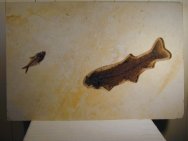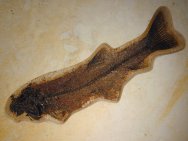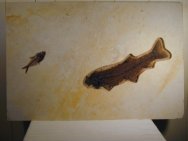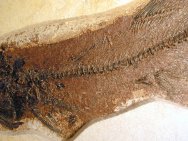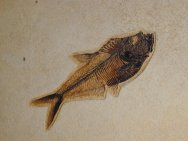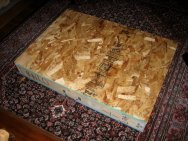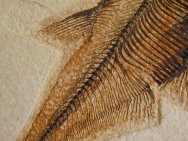|
The
plate measures 3 by 2 feet. |
Description:
These 50 million year old, Eocene-Era fish fossils come from one
of the world's famous Laggerstatten, the Green River Formation in
Wyoming. A small portion of the fish fossils from Green River exhibits
such fine preservation. The significant extent of soft-tissue preservation
that makes the site famous is evident in this specimen. The lucky
owner may wish to frame this world class display fossil which is
on a plate measuring 3 by 2 feet.
Genus
Notogoneus is one of the uncommon taxa offered from the Green River
Formation, and with a maximum total length of 91 cm, one of the
largest. The Gonorynchidae are a marine family of fishes commonly
called “sand fish” which are found today in the near-shore
regions of the Indo-Pacific.
|
This
specimen comes from the so-called 18 inch layer noted for
the fish coming out complete on one side of the matirx and
exquisite soft-tissue preservation. |
Fossil
members of the family are found in North America, Europe, S.W. Asia,
and Australia. The down-turned mouth is an indicator of its feeding
habits: it most likely fed upon prey animals living on the lake
bottom. Its scarcity is thought to be a result of the fact that
the lake was thermally stratified most of the time, rendering the
bottom anoxic, and thus uninhabitable for most of the year. The
Notogoneus is thought to have migrated into the lake to feed only
during the season of annual turnover when the lake bottom would
have been non-toxic.
The
smaller fish is Diplomystus dentatus. Early workers proposed that
this fish was closely related to Knightia, an incorrect assumption,
as Diplomystus is not even placed within the same Order. 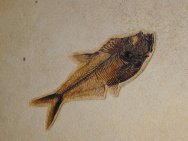 Diplomystus
has the body form and mouth placement of a surface feeder, as is
thought to have been a predator of smaller surface-feeders such
as Knightia. Indeed, specimens of Diplomystus have been found with
Knightia in their stomachs or mouths, a classic demonstration of
a predator caught by its prey! Diplomystus
has the body form and mouth placement of a surface feeder, as is
thought to have been a predator of smaller surface-feeders such
as Knightia. Indeed, specimens of Diplomystus have been found with
Knightia in their stomachs or mouths, a classic demonstration of
a predator caught by its prey!
About
the Green River Formation: Class Actinopterygii, the ray-finned
bony fishes, comprise almost half of all known species of vertebrates,
some 20,000 extant species. There are numerous locations worldwide
that are noted for wondrous preservation of bony fishes, and the
Green River formation that covers some 25,000 square miles of SW
Wyoming, west Colorado and east Utah is one of the premier examples.
The formation is one of the largest lacustrine sedimentary accumulations
in the world, and spans the period from 40 to 50 million years ago
during the Eocene Epoch.
During
the Eocene, based on the fossil record, the region was sub-tropical
to temperate. Some 60 vertebrate taxa have been described from the
formation, including crocodiles, boa constrictors, and birds, as
well as abundant invertebrates and plants. The unusually excellent
preservation of the Green River fish fossils is usually attributed
to a combination of two factors: 1) a cold period during the Eocene
that would have caused dead fish to sink faster due to a less inflated
swim bladder; and 2) the great depth of the lakes and the consequent
anoxic conditions that would have often prevented scavengers from
disturbing the carcasses.
| Shipped
in styrofoam lined Custom Crate: 80 pounds & 42 x 30 x 7
inches |
|
